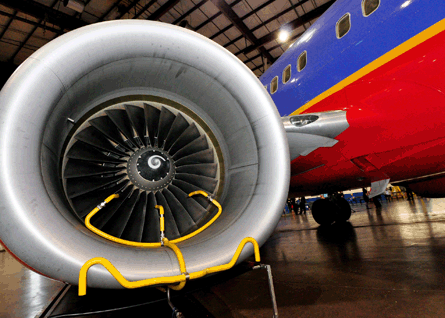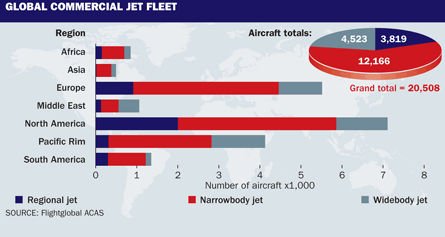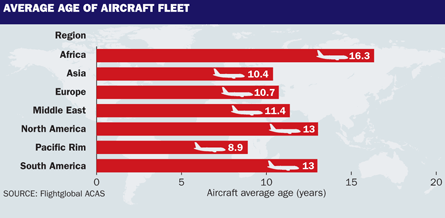Time is of the essence for some North American carriers that opted to defer heavy airframe maintenance on their narrowbody fleets during the economic downturn, and the heavy hitters in the business are positioning to cater to the needs of some of their most prized customers.
North American heavy airframe maintenance expenditure should reach $2.3 billion this year, up from the $2.1 billion spent in 2010, based on estimates from analysts at international management consulting firm Oliver Wyman. Almost 4,000 narrowbodies are in the active North American fleet (see chart).
"We believe the global market in 2011 will grow for airframes, as many airlines will restock depleted inventories and engage in maintenance activities deferred in prior years," the analysts say.
 |
|---|
© Southwest AirlinesSouthwest looks beyond US borders for maintenance |
Air Canada is in that exact situation. A decrease of C$19 million ($19.4 million) triggered by deferrals of Airbus A320 heavy maintenance helped push the carrier's overall fourth quarter 2010 maintenance expense down 14% to C$173 million compared with the same quarter in 2009. The airline expects to complete the narrowbody airframe maintenance during the next 12 months.
Large MRO providers that supply comprehensive maintenance are already benefiting from carriers looking to complete narrowbody heavy maintenance. Illinois-based AAR has 40-50 aircraft every day undergoing various maintenance tasks across its four bases, says vice-president of commercial sales and planning Jack Arehart. "We're seeing a lot more long-term nose-to-tail commitments than we saw a few years ago," he says, with demand close to reaching pre-recession levels.
AAR's 2008 purchase of Avborne gave the company an important foothold into Airbus narrowbody heavy maintenance, says Arehart, and AAR Miami has worked with numerous lessors, including those seizing aircraft from Mexicana after it entered creditor protection in August. AAR Miami completed checks on A320 family aircraft previously operated by Mexicana and has performed modification work for Virgin America in Miami.
North Carolina-based Timco's performance for an unnamed customer on a trial basis from September to December 2010 resulted in the operator adding a second line of Boeing 737 heavy maintenance at its Greensboro, North Carolina facility, allowing it to maximise its four-hangar capacity, says its senior vice-president of sales and marketing John Eichten.
|
|
|---|
|
|
 |
But Eichten concludes there is "probably a little excess capacity" in the North American heavy airframe maintenance market.
A fellow North Carolina newcomer, NS Aviation, could be tipping available airframe capacity higher. It formally opened for business in January at Smith Reynolds airport in Winston-Salem on premises initially built by Piedmont Airlines and previously occupied by US Airways and defunct Pace Airlines. NS was awarded Part 145 repair station certification and is targeting the competitive 737 heavy airframe maintenance market.
Breaking the barriers erected by titans like AAR and Timco - which offer a range of engineering and inventory support solutions to complement heavy maintenance - is no easy feat. Part of Timco's allure is the data it has built from its heavy airframe maintenance experience that helps it have the right parts on hand for the inevitable non-routine task that turns up during heavy maintenance.
NEW ENTRANTS
It is critical for an unknown like NS to secure a launch customer quickly, says Mike Hooven, formerly of Moog and now head of MJH & Associates. He believes new entrants need to realise the importance of ratcheting up their marketing spend to compete effectively.
But the real competition for North American MRO providers remains from Latin American and Asian repair companies, says Sridhar Chandrasekaran, senior vice-president of strategic services at consultancy Realization. He concludes those providers can quote much lower prices than their North American counterparts.
Eitchen of Timco says it is important to factor in aircraft ferrying costs when analysing offshore maintenance spend. Chandrasekaran concedes ferrying expense becomes a "grey area" when evaluating potential maintenance suppliers. "For a shorter C check, shaving a few days of turn time would be a big advantage as the time required to send these planes back and forth from Latin America or China - and the lost revenue - would not make up for the lower labour rates. Therefore, North American MROs can compete with Chinese and Latin American MROs by offering reduced turn times."
Yet the world's largest 737 operator, Southwest, says even with the higher cost of ferrying, "it is still more economical for us to use Aeroman", the El Salvador-based affiliate of Canadian MRO Aveos. "There are many options within the US for heavy airframe maintenance, and we are always looking at what our needs are versus what various MROs have to offer," Southwest says. "However, we are constantly comparing those options in the US to those that are international."
Southwest vice-president of maintenance Brian Hirshman has labelled Aeroman's performance "very good", adding: "We monitor it closely, as we do with all the other MROs, and they are as good if not better." Southwest also uses AAR, Aviation Technical Services and has contracted crown work to Timco on its classic 737-300s/500s. The carrier says Timco "will be considered for future heavy checks".
But heavy checks performed by MROs in the future could differ from the traditional work performed during heavy airframe maintenance. VZM Management Services, in analysing the commercial aviation and maintenance market for this year, concludes that the introduction of equalised maintenance, particularly in narrowbody heavy maintenance business, could reshape MRO business models. By incorporating some of the heavy check tasks into A-checks and line maintenance functions, turnaround times for heavy checks can be cut.
Part of a drive by Timco in growing its LineCare product is to give operators a solution as more maintenance gets pushed to the line through equalised programmes, says Eichten.
Equalised programmes appear to be in their infancy. While they seem tailored to help low-cost carriers maintain their typically higher utilisation levels, JetBlue Airways, which operates 115 A320s averaging six years in age, opts not to use phased checks, electing for full checks rather than phasing them.
Arehart of AAR does not see a lot of equalised maintenance being performed on non-warranty aircraft, and cautions that to manage additional work cards into nightly maintenance means that the necessary mechanics and tooling also have to be available.
Overall, AAR is confident of its competitive stance in the current market and its capability to handle higher airframe maintenance demand. "With the exception of very sporadic spots we're basically full in all our facilities," says Arehart, "for a fairly good future outlook."
- Southwest chief Gary Kelly discusses future narrowbodies
Source: Flight International

























